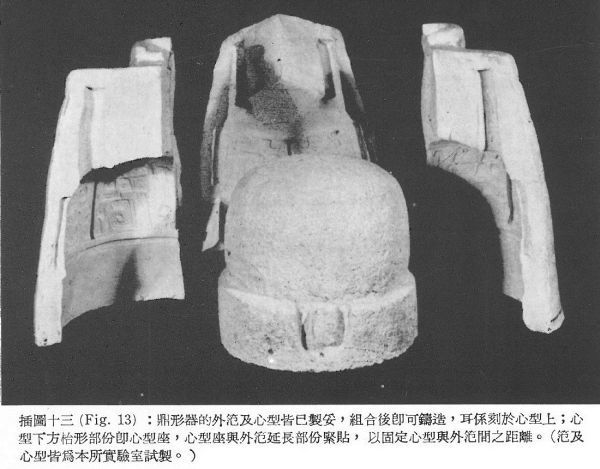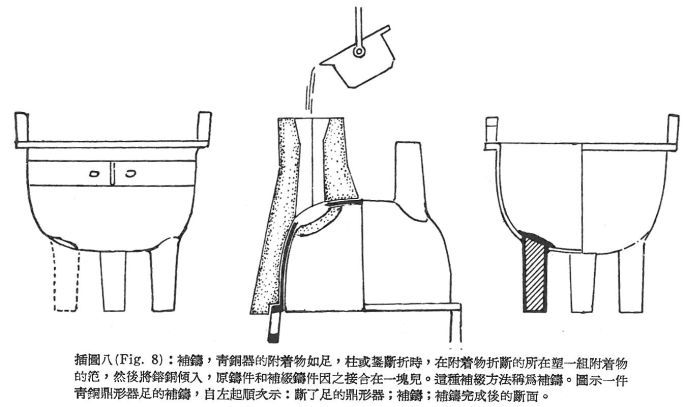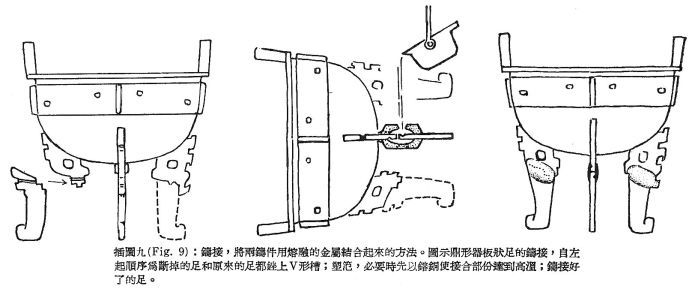Jul 16, 2018 © Ulrich Theobald
Agriculture
As in later ages, agriculture was the base of economy during the Shang period 商 (17th-11th cent. BCE). Oracle bone inscriptions mention several types of ploughs (ji 耤, li 犂), as well as different types of fields, but the extent of cadastral survey and modes of field ownership are unknown.
Various types of grains are known, like glutinous millet (shu 黍) and black millet (ju 秬), but wheat (mai 麥) and dry-field rice (dao 稻) might have been cultivated, too, as well as hemp and mulberry trees for raising silkworms.
Wine (jiu 酒) was widely used for banquets as well as for the many sacrifices delivered to ancestors (see Shang religion). The Shang apparently consumed so much wine that the kings of the Zhou dynasty 周 (11th cent.-221 BCE) repeatedly warned not to become slaves of drunkenness.
For the same reason, cattle breeding played an important part in Shang agriculture. Animals were raised not only for consumption in the "metropolis" cities of Erligang 二里崗 and Anyang 安陽, but also to serve as sacrifices to the ancestral spirits.
Horses were bred for warfare, and also to draw chariots and carts. The Shang used as much as 10,000 cavalry troops in one campaign (Yin and Cao 1994: 102).
Bronze casting
While bronze casting was invented at the beginning of the 2nd millennium BCE in northwest China, the Shang period witnessed the industrialization of this technique with the help of clay moulds. Many Shang-period sites include workshops where the needs for ritual bronze vessels of the upper class were met. In southern places like Panlongcheng 盤龍城, Hubei, or Xingan 新干, Jiangxi, musical instruments like bells (nao 鐃, zheng 鉦, ling 鈴, bo 鎛) and drums must be added to the range of bronze tools, as well as various fittings for chariots, and various working tools (shovels, hoes) and weapons (arrowheads, spearheads).
Weapons, either ceremonial like axes (yue 鉞), or for real use like knives, swords, arrowheads, bow fittings or ge-type 戈 dagger-axes were also made (see Shang military). Hoes (chu 鋤), mattocks (jue 钁), adzes (ben 錛) and spades (chan 鏟) were occasionally found, but the production of metal ploughs or other agricultural implements was not common. This means that the precious alloy of bronze was more or less reserved for use by the upper class, and not by commoners (Yin and Cao 1994: 99). The use of drills (zao 鑿) were common to pierce stones.
Instead of with bronze, quite a range of tools like spades, sickles (lian 鐮), knives (dao 刀) or axes (fu 斧) was made of various types of stone.
Handicrafts
A great number of Shang-period sites includes workshops, which were often located outside the city. In these worksops, furnaces were found, models, moulds and rawlings.
In Gaochengtai 藁城台, Shandong, and Liujiahe 劉家河 in Pinggu 平谷 close to Beijing, bronze yue-style axes with iron blade were found. According to chemical analysis, the iron originated in meteors (Wu 1994: 169; Taylor 1988).
Craftsmen were responsible to cut, polish and prepare oracle bones, and to cut in holes or cavities that were to receive a heating tool producing auspicious or inauspicious cracks for divination. When the divinatory process was over, the inquiry and its result was carved into the bone.
Workers polished and drilled stones and carved out, either as bas-relief (jiandiao 淺雕), or as high relief (fudiao 浮雕), shapes and figures into precious stones like nephrite or jade, marble (dalishi 大理石), "green crystal" (lüjing 綠晶), malachite (kongqueshi 孔雀石), agate (manao 瑪瑙), bone, or ivory. Craftsmen chiseled, drilled and sanded out figures of real or imaginary animals, and occasionally also anthropomorphical figures.
Soundstones (qing 磬) made of dense mineralic stones belonged to the repertoire of Shang-period musical instruments.
Jade was a highly venerated material and served for many ritual objects like daggers or axes, square tubes (cong 琮), disks (bi 璧), rings (yuan 瑗), short, pointed "scepters" (gui 圭), long, sword-shaped "sceptres" (zhang 璋), ring segments or "arcs" (huang 璜), or nearly closed rings (jue 玦). Alone in the tomb of Queen Fu Hao 婦好 which was excavated in 1976, more than 700 pieces of jade were found, among them of course also jewelry like pendants, rings, earrings, hairpins, and a thumb ring. Mineralic analysis showed that the jades in the tombs of Anyang hailed from Khotan in Xinjiang, Xiuyan 岫岩 in Liaoning, oder Nanyang 南陽 in Henan.
Some bronze items were decorated with turquois stones (lüsongshi 綠松石), others plated in gold, particularly in the area of the Sanxingdui Culture 三星堆文化 in modern Sichuan (Yin and Cao 1994: 122).
Apart from the very impressive bronze vessels, Shang-period tombs included huge numbers of ceramic vessels, part of which was glazed. Shang-period earthenware was based on models of the Longshan 龍山文化 (3200–1850 BCE), Yangshao 仰韶文化 (5000–2000 BCE) cultures, but refined and changed these earlier types and shapes. Many of the earthenware types were transformed into the material bronze. Craftsmen made use of models and wheel and so helped to standardize shapes, forms, and types.
The site of Erligang included a 1,400m2-large pottery workshop with no less than 14 kilns. Average ceramics was "gray pottery" (huitao 灰陶), "red pottery" (hongtao 紅陶), or "black pottery" (heitao 黑陶), while such of higher quality, made of kaolin, was whitish (baitao 白陶. They were burnt at temperatures higher than 1000° (Yin and Cao 1994: 108). Specimen of this type of proto-porcelain (yuanshi ciqi 原始瓷器) were found in Yantai, Henan, and Panlongchen, but during the Anyang phase also farther in the north. Some scholars believe that the proto-porcelain hailed from the southern outskirts of the Shang realm (Campbell 2014: 92, 101).
Quite a number of ceramic vessels were perhaps not created for everyday use, but particularly for use as burial objects (mingqi 明器, also written 冥器 "tools [made] for the darkness").
There is evidence of widespread sericulture in Shang China, as the term spinning and weaving are mentioned in oracle bone inscriptions. Traces of textile were found in the tomb of Fu Hao, where bronze vessels had been wrapped with fabric. From the Erlitou period 二里頭文化 (2000–1500 BCE) on, the decoration on pottery was made by applying textiles on the still-soft surface. Some of the textiles showed an extreme density, with 72×26 strands per cm2 (Wu 1994: 133).
Traces of lacquer are found in tombs, either from wooden vessels lacquered in red, or on the coffin, for example, of Queen Fu Hao. While the wood has decayed, the lacquer coating remains, at least partially (Yin and Cao 1994: 112).
Chariots which were introduced into China during the Anyang period, were often used as burial offerings. Yet all wooden parts have decayed, and only "shadows" remain. With the help of these and of the surviving metal fittings, the shape of chariots can be reconstructed. Chariots found in Anyang, Subutun 蘇埠屯, Shandong, and Laoniupo 老牛坡 close to Xi'an 西安, Shaanxi, resemble each other very closely, which means that there was a type of standard chariot. The site of Xiaotun 小屯 in Anyang reveiled cart tracks with a width of just 1.5m, while that of the chariots was 2.2-2.4m (Yin and Cao 1994: 126-127). This means that there was a difference beetween chariots for war or hunting, and civilian carts.
Boats were not discovered so far, but are mentioned in oracle bone inscriptions.
Figure 2. Reconstruction of a Shang-period chariot
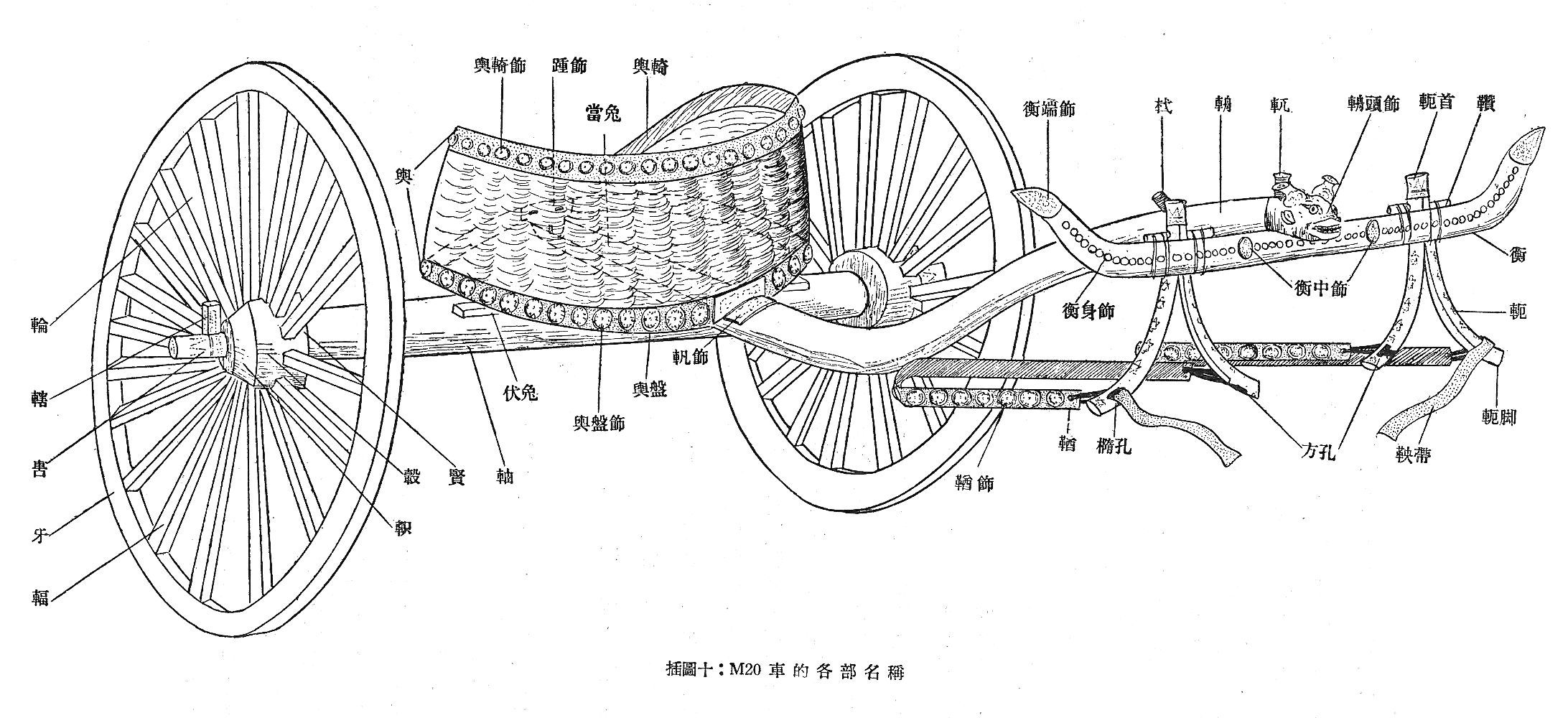 |
Source: Shi (1970), Vol. 1, 28 (Plate 10). |
Construction work
Most Shang-period cities were protected by a city wall, some also with an outer moat. The city wall of Erligang was 7km-long and had 11 gates (Yin and Cao 1994: 105). The city of Panlongcheng was 290×260m large, with just four gates in an irregular wall. Anyang was not protected by a city wall (at least, no wall has been discovered so far). Another reason might be that there was a sufficient number of garrisons in Anyang for defense (see Shang military; Chang 1980: 134).
Excavations in Anyang laid free more than 50 buildings arranged in three complexes. These were temples, palaces, and perhaps administrative buildings.
Shang buildings and palaces as discovered in Anyang and Erligang were considerably huge constructions entirely made of perishable materials. The basement was pounded earth (hangtu 夯土), and the main pillars were protected from rotting by a stone (shichu 石礎) or bronze base (tongchu 銅礎). The palace of Erlitou was 108×100m long. The basement can be called a kind of terrace (tai 臺), a kind of construction already known in the Longshan and Liangzhu 良渚文化 (3400–2000 BCE) cultures.
The houses of the Shang period gradually went away from the mode of subterranean dwellings (xueju 穴居) to overground buildings. The larger ones consisted of a great hall in the back, a courtyard for ceremonial use (ting 庭), and side wings (wu 廡). The size of pillars indicated that the roofs might have impressive size.
Figure 3. Building foundation in Anyang
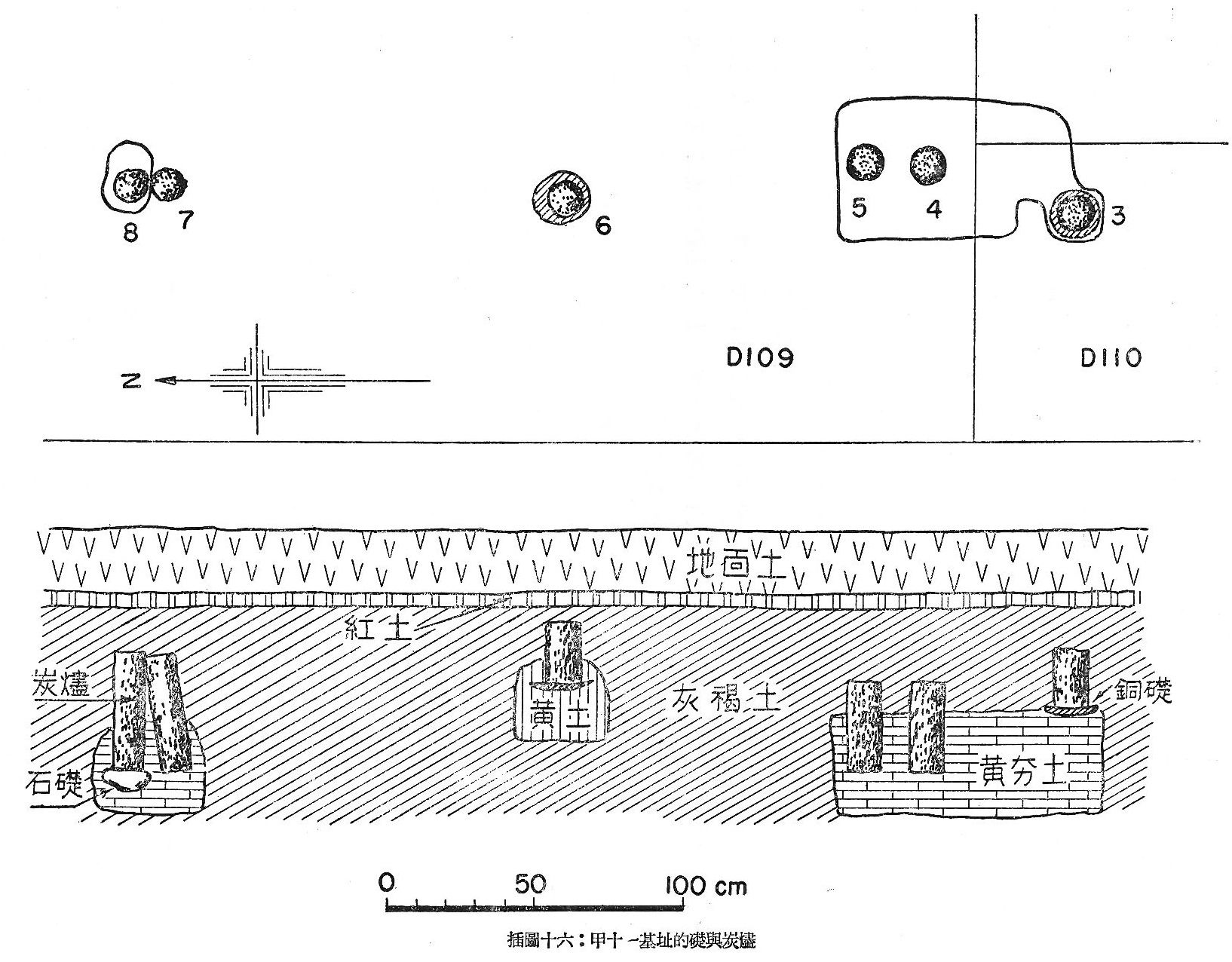 |
The drawings (top view and cross section) shows the positions of stone (shichu 石礎) and bronze bases (tongchu 銅礎) for the pillars of a buildings. The whole construction is inserted into pounded-earth sections. From Shi 1959: 48 (Plate 16). |
Royal tombs as constructed in the last period of Shang were giant complexes with a deep shaft and longs ramps leading down into the burial chamber. The construction of the tombs alone must have required huge manpower.
Figure 4a-b. Building complex and shaft of a royal tomb in Anyang
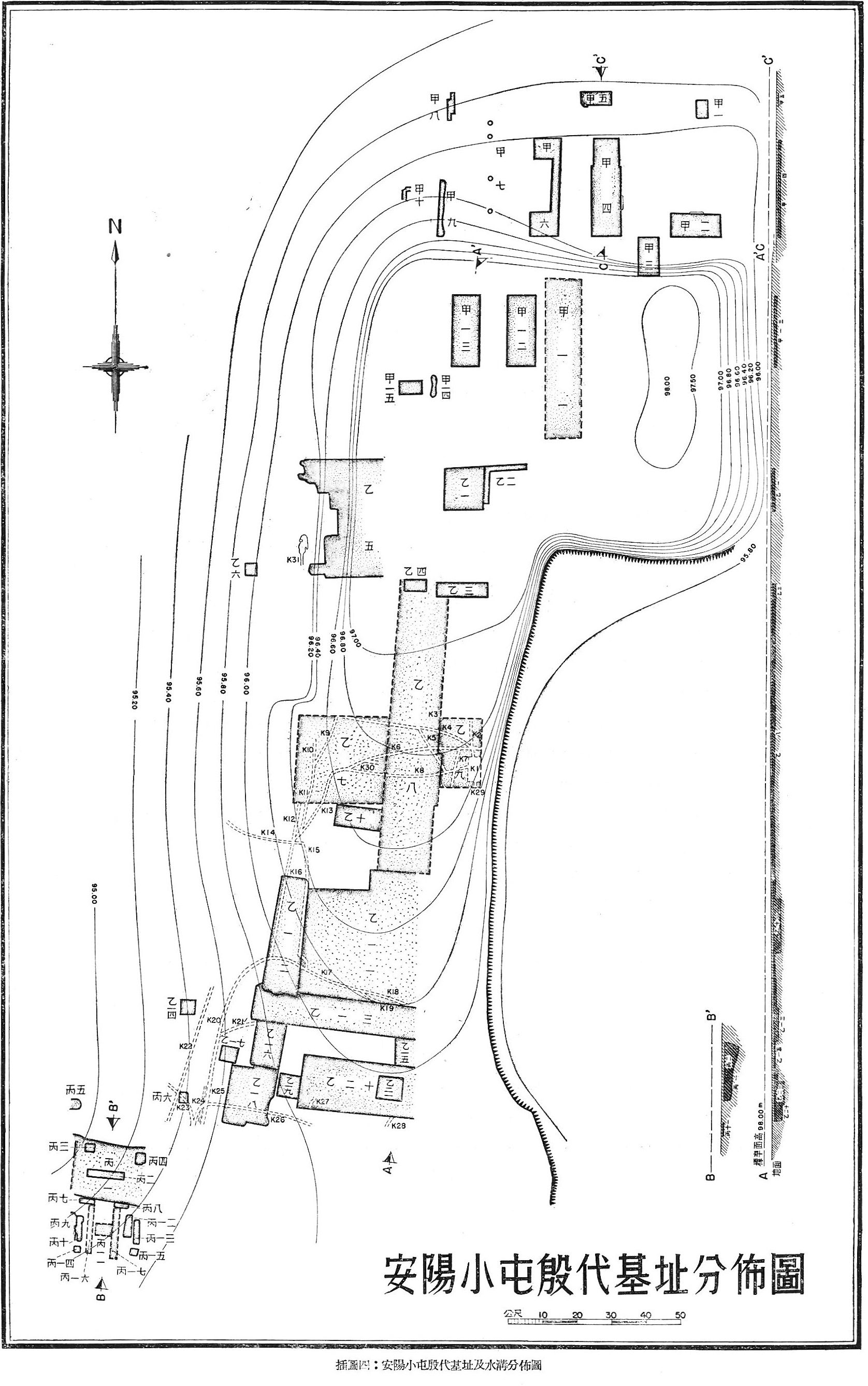 |
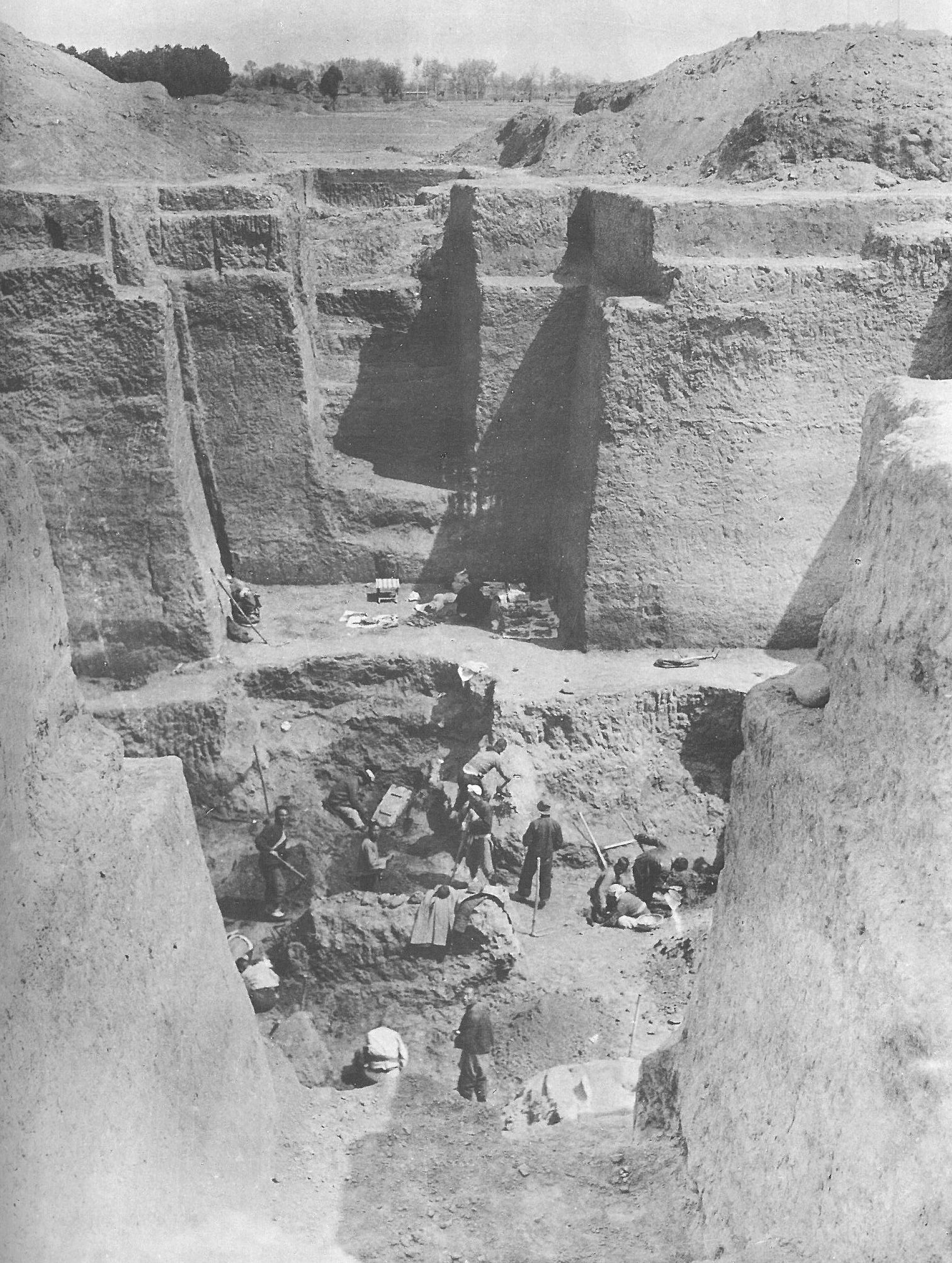 |
The drawing to the left shows the whole building complex of Anyang. It is divided into a northern, a central, and a southern complex. The length of all three complexes is about 300m. From Shi 1959: 21 (Plate 4). The photo to the right showed excavators in work during the inspection of tomb M1001 in Anyang. The men are standing in upper parts of the tomb chamber, which has the shape of a cross with short legs. Ramps are coming down from all four sides, the photographer standing in one of them. From Gao (1962), Vol. 2, Plate VI. |
Figure 5. Construction of a canal in the building complex of Anyang
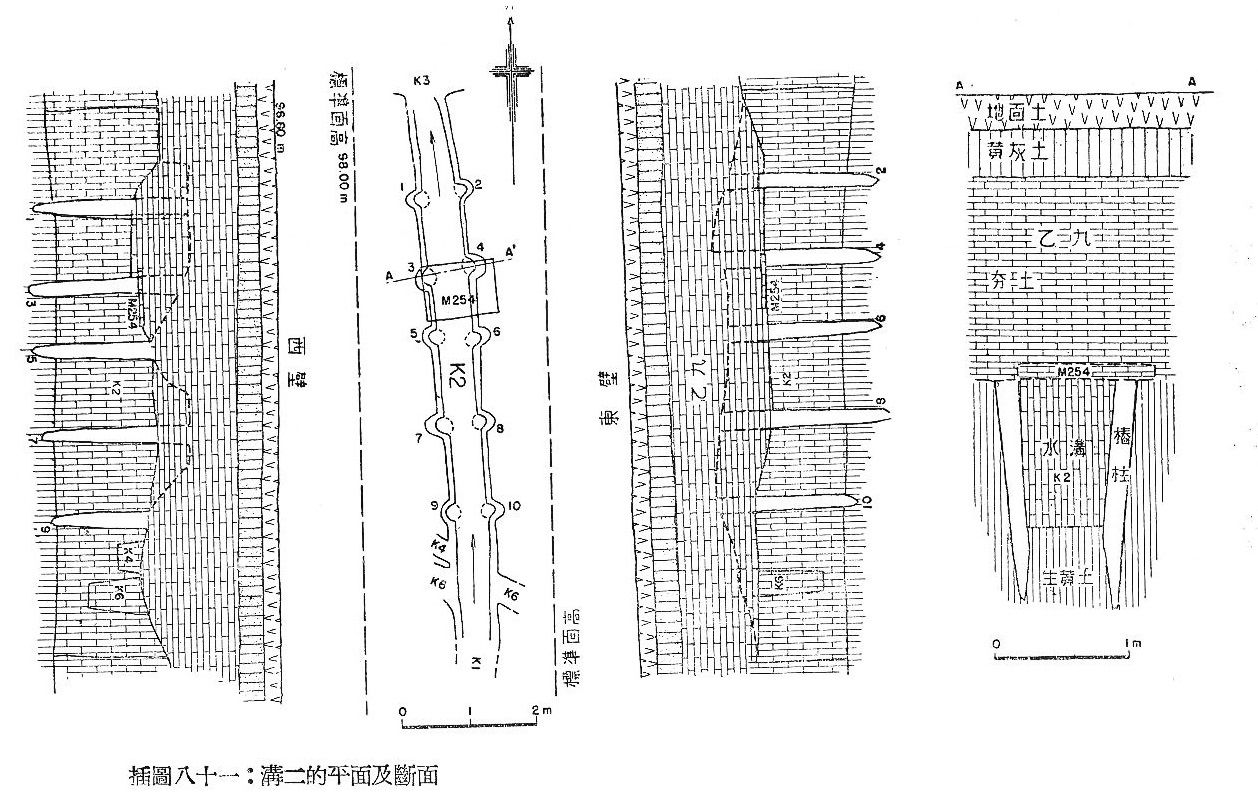 |
Canal system in Anyang, top view, longitudinal sections, and cross section (right). The drawings shows the positions of wooden posts and the types of soil. From Shi (1959): 206 (Plate 81). |
Figure 6. Tubes of a canal system in Yanshi
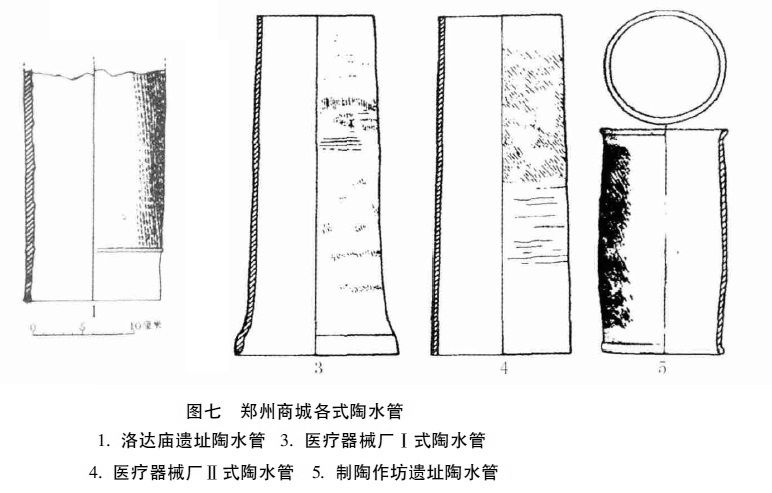 |
Segments of a water pipe constituting a canal system in the city of Yanshi. From Zhang (2015), fig. 7. |
Surprisingly enough, the labour conscripts did not engage in waterwork, notwithstanding Karl Wittfogel's (1896-1988) theory of the hydraulic empire. The digging or irrigation canals or the erection of dams seemed not to be within the crucial tasks of the kings of Yin, like it became later one of the most important charges of the Chinese rulers.
The Chinese Calendar
Dating was an extremely important part of oracle bone inscriptions, not just because the court expected the results of harvest or other agricultural events, but also because sacrifices were due at fix days. For this reason, the calendar played an important role. The Chinese calendar was from the beginning a combination of a lunar calendar (yueli 月曆) with twelve months (cycles of the moon) with the solar year, determined by the summer and winter solstices.
The year consisted of four seasons, 24 "mini-seasons" or solar terms (ershisi jieqi 二十四節氣), and ten-day weeks (xun 旬). The days of each week were counted by a series of "numbers" called the Ten Celestial Stems (shi tiangan 十天干). These numbers were also used as designations for branches of the royal house. The Ten Celestial Stems were combined with the "numbers" of another cycle, the Twelve Terrestrial Branches (shi'er dizhi 十二地支) - or half of them -, resulting in a cycle of 60 combinations. These sufficed to count the days of two months or the years of an average human life. A year with 360 days includes six complete stem-branch-cycles. The full cycle is recorded on several oracle bones (Yin and Cao 1994: 113).
Table 1. The Ten Celestial Stems (shi tiangan 十天干)
| 1 |
甲 jia |
| 2 |
乙 yi |
| 3 |
丙 bing |
| 4 |
丁 ding |
| 5 |
戊 wu |
| 6 |
己 ji |
| 7 |
庚 geng |
| 8 |
辛 xin |
| 9 |
壬 ren |
| 10 |
癸 gui |
Table 2. The Twelve Terrestrial Branches (shi'er dizhi 十二地支)
| 1 |
子 zi |
| 2 |
丑 chou |
| 3 |
寅 yin |
| 4 |
卯 mao |
| 5 |
辰 chen |
| 6 |
巳 si |
| 7 |
午 wu |
| 8 |
未 wei |
| 9 |
申 shen |
| 10 |
酉 you |
| 11 |
戌 xu |
| 12 |
亥 hai |
Figure 7. Writing exercise on a piece of bone
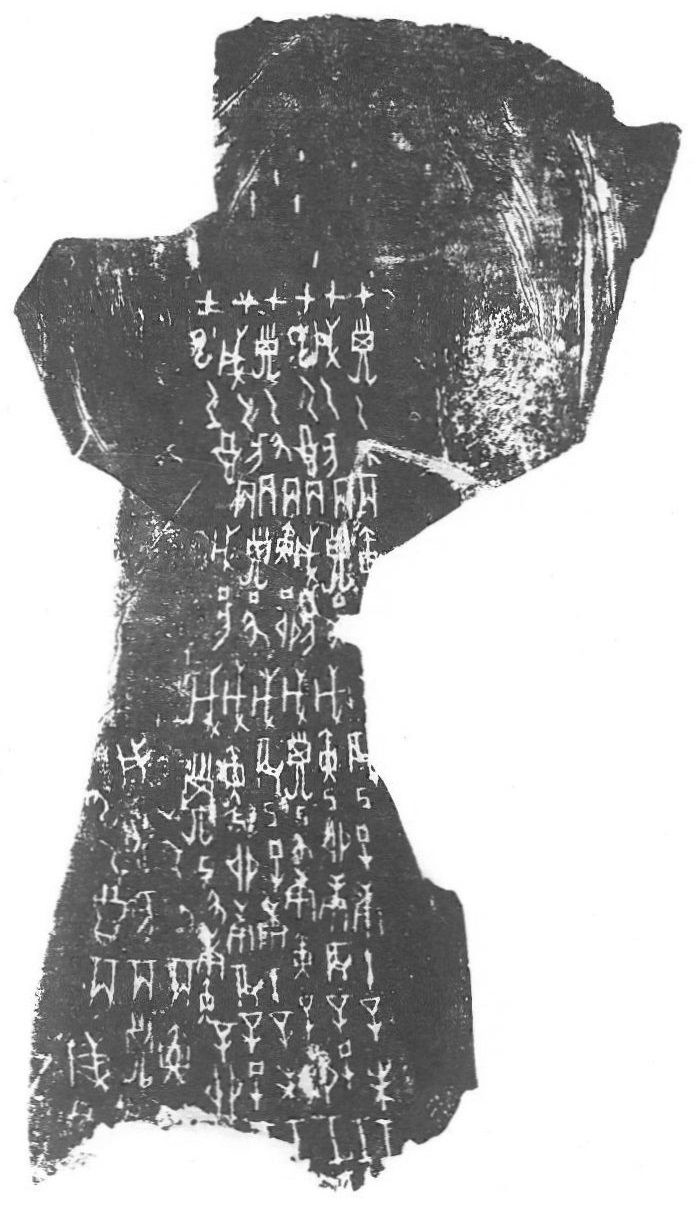 |
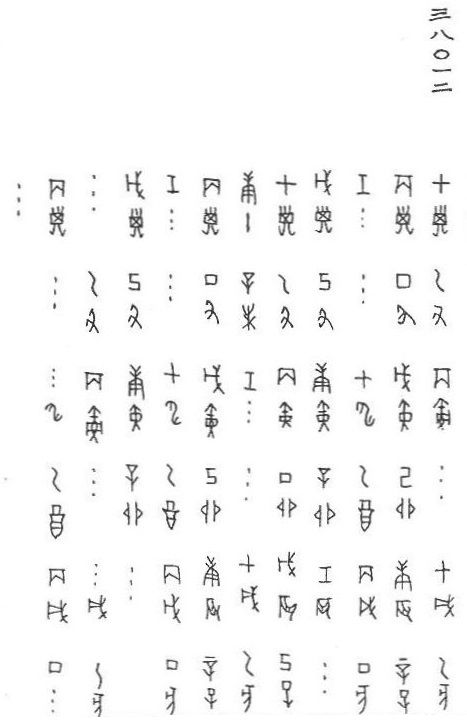 |
Exercise of carving (xike 習刻) the units of the sexagenary cycle (ganzhi 干支), rubbing of a shoulderblade. From Guo and Hu (1978ff.), Vol. 12, no. 38012, transcription Yao and Xiao (1989), Vol, 2, no. 38012. |
Hints on the use of solar terms are found in the Confucian Classic Shangshu 尚書 "Book of Documents", ch. Yaodian 堯典. Traces of an ancient calendar are seen in the text Xia xiaozheng 夏小正 "Small Calendar of the Xia" and the chapter Yueling 月令 of the ritual classic Liji 禮記.
The problem to reconcile the lunar with the solar year led to the decision to make use of long, 30-day months (dayue 大月), and short, 29-day months (xiaoyue 小月). In early oracle bone inscriptions, a thirteenth month is used (shisanyue 十三月), which served to fill the gap between the solar and the lunar year cycle. In the late Shang period, the "thirteenth month" was shifted from the end of the year to an intercalary position, as is common use in the traditional Chinese calendar, where it is called runyue 閏月 (Yin and Cao 1994: 114).
The combination of the solar with the lunar year resulted in an year cycle with a length of 365¼ days. The old calender was therefore called sifenli 四分曆 "Quarter Calendar".
The word nian 年 (actually written 秊), today meaning "year", was the Shang word for harvest, and consists of the words 千 "thousand" and 禾 "grain ear". The contemporary word for "year" was sui 歲 and perhaps si 祀, which actually means "offering". The word siji 祀季 meant a quarter of a year, or a "sacrificial cycle", during which ancestral spirits were presented offerings according to a certain schedule (see Shang religion, Fig. 1).
The Shang used many different term for times of the day. This was important for the performance of certain sacrifices. Inscriptions mention the words day (ri 日), night (xi 夕), noon (zhongri 中日), dawn (dan 旦), dusk (hun 昏 or luori 落日, written 各日), morning (zhao 朝), afternoon (ze 昃), grand meal (dashi 大食) and lesser meal (xiaoshi 小食).
The Shang observed not just the starry sky, but also meterological phenomena, and recorded them acribically, and discerned between various strenghs of wind or rain or other types of precipitations.
Numerous records of eclipses of sun (rishi 日食) and moon (yueshi), and discernd between partial (not recorded) and total eclipses (designated as 聞, i.e. 昏). Extraordinary phenomena like "new stars" are also recorded.
Arithmetics
The Shang used all numbers known in modern Chinese: single digits, and the digits ten (shi 十), hundred (bai 百), thousand (qian 千) and ten thousand (wan 萬). Complex numbers like 2,656 are seen in inscriptions; the highest number found in oracle bone texts is 30,000 (Yin and Cao 1994: 116). The method of adding single digits by you 又 "and" was common (like "fifty and six" = 56). Counting was important for the control acreage, the number of cattle, or for astronomical calculations, and certainly also for construction projects.
Calculation in tens or in steps of five was widespread. The concepts of odd numbers (qishu 奇數) and even number (oushu 偶數) was known, just like and multiples (beishu 倍數). This was particularly important to express individual status by offering sacrificial animals or furnishing tombs with certain numbers of vessels or other objects.
Medicine
Oracle bone inscriptions include reports about various diseases of men, animals and crops. These might be first traces of a kind of "observal medicine".
The inquiries in divinatory texts speak often of aches in all parts of the royal body. Medical terms using the word "wind" are common. This shows an ealy use of the concept of winds as origis of diseases (fengji 風疾).
A story mentioned by the Daoist master Huangfu Mi 皇甫謐 (215-282) (Jiayi jing 甲乙經) tells that chief minister Yi Yin 伊尹 (perhaps in the function of a medium) once prepared a medicine for king Tang the Perfect 成湯.
A tomb in Gaochengtai 藳城臺, Hubei, revealed leftovers of plants, which might have been medicine.
The same tomb included a lacquered box containing a stone tool which was perhaps a medical instrument (Yin and Cao 1994: 118).
Some palatial buildings of Erligang, Yanshi 偃師, and Anyang included drainage tubes of earthenware, perhaps used to discard wastewater - an early proof of hygiene in private homes (Yin and Cao 1994: 119; Li 2011; Zhang 2015). The building complex in Anyang included a complex canal system, in which the walls were stabilized by wooden posts. Other evidence for hygiene is the use of the expressions mu 沐 and yu 浴 in oracle bone inscriptions, both meaning to wash or to bathe.
Geographical knowledge
More than 500 place names are mentioned in oracle bone inscriptions. The repeated transfer of the royal seat to another place – historiographical sources speak of 13 transfers – shows that the Shang were familiar with the geography of a wide area in the Central Plain. Moreover, there was constant warfare between the Shang kings and recalcitrant regional lords, involving huge numbers of troops – between 3,000 and 13,000 (Yin and Cao 1994: 129) which made knowledge of distant regions necessary.
The Chinese script
The appearance of the Chinese script in King Wu Ding's 武丁 (trad. r. 1324-1266 BCE) reign is no proof that a kind of script was invented and used exclusively in Yin (today's Anyang, Henan) and from this time on, but doubtlessly, the decision to records the outcome of divinations was an important step in cementing important elements in what was to become Chinese culture.
The oldest traces of script on pottery were found in Linzi 臨淄 in the 1870s and Chengziya 城子崖, both Shandong, in the 1920-30s, and also in Anyang. In all instancs, characters served rather as markers than as script (Chang 1980: 241). Chinese writing thus had its roots in the marking of pottery for social identification. Unlike in the Near East (Sumer, Babylon, Egypt), where writing begain with the use of accounting, the earliest written texts in China were political in nature (Chang 1980: 247-248). Campbell (2018: 123) contradicts this assumption and holds that the Shang also compiled inventories, and not just records of divinations.
The first Chinese characters appear on hard materials as oracle bones and bronze vessels. Yet it must be assumed that the script was invented and used before on non-durable material like bamboo or wooden slips. The chapter Duoshi 多士 in the Classic Shangshu holds that the Shang made use of archives (cedian 典). Precursors of the script can be seen in markers on pottery found in Neolithic sites.
The basic modes of putting together characters are fully developed in oracle texts: pictographs (xiangxing 象形) or "pictures", ideographs (zhishi 指事) expressing an idea, combinations of two characters (huiyi 會意) forming a new one, combinations of shape and sound (xingsheng 形聲) expressing the field of meaning together with a pronunciation, and borrowing (jiajie 假借) a character for another one.
The language of the oracle bone inscriptions, Early Archaic Chinese, is full of specific terms and makes use of characters that later disappeared. About 2,000 characters can be interpreted, while many others have an unknown meaning. The text is hardly to understand even if one has learned to read Classical Chinese.
Sources:
Campbell, Roderick (2018). Violence, Kinship and the Early Chinese State (Cambridge: Cambridge University Press).
Chang, Kwang-chih (1980). Shang Civilization (New Haven/London: Yale University Press).
Gao Quxun 高去尋, ed. (1962). Houjiazhuang (Henan Anyang Houjiazhuang yindai mudi), 2, 1001 hao damu 侯家莊(河南安陽侯家莊殷代墓地)第二本:1001號大墓 (Taibei: Zhongyang yanjiuyuan lishi yuyan yanjiusuo). (Series Zhongguo kaogu xuebao ji. 3 中國考古學報告集之三)
Guo Moruo 郭沫若, Hu Houxuan 胡厚宣 (1978-1982). Jiaguwen heji 甲骨文合集 (Beijing: Zhonghua shuju).
Li Ji 李濟, Wan Jiabao 萬家保, ed. (1970). Gu qiwu yanjiu zhuankan 古器物研究專刊, Vol. 4, Yinxu chutu qingtong dingxing qi zhi yanjiu 殷墟出土青銅鼎形器之研究 (Nangang: Zhongyang Yanjiuyuan Lishi Yuyan Yanjiusuo). (Zhongguo kaogu baogai ji xinbian 中國考古報告集新編)
Li Qinglin 李清臨 (2011). "Anyang Yinxu chutu tao shuiguan de gongyi yu jishu yanjiu 安陽殷墟出土陶水管的工藝與技術研究", Jiang-Han kaogu 江漢考古, 2011/2: 103-107.
Shi Zhangru 石璋如 (1959). Xiaotun (Henan Anyang Yinxu yizhi zhi yi), 1, Yizhi da faxian yu fajue, Yibian, Jianzhu yicun 小屯 (河南安陽殷墟遺址之一)第一本,遺址的發現與發掘:乙編,建築遺存 (Nangang: Zhongyang Yanjiuyuan Lishi Yuyan Yanjiusuo)
Shi Zhangru 石璋如, ed. (1970). Xiaotun (Henan Anyang Yinxu yizhi zhi yi), 1, Yizhi de faxian yu fajue, Bingbian, Yinxu muzang, 1, Beizu muzang 小屯(河南安陽殷墟遺址之一)第一本:遺址的發現與發掘:丙編,殷墟墓葬之一,北組墓葬 (Taibei: Zhongyang yanjiuyuan lishi yuyan yanjiusuo). (Series Zhongguo kaogu xuebao ji. 2 中國考古學報告集之二)
Taylor, Sarah (1988). "Early Chinese Iron Technology: Some Social and Historical Implications", Cina, No. 21, XXXth European Conference of Chinese Studies Proceedings: 319-338.
Wittfogel, Karl (1957). Oriental Despotism: A Comparative Study of Total Power (New Haven, CT: Yale University Press).
Wu Yaoli 吳耀利 (1994). Zhongguo yuangu ji sandai yishu shi 中國遠古暨三代藝術史 (Beijing: Renmin chubanshe). (Zhongguo quanshi, bai juan ben 中國全史,百卷本)
Yao Xiaosui 姚孝遂, Xiao Ding 肖丁, ed. (1989). Yinxu jiagu keci leizuan 殷墟甲骨刻辭類纂 (Beijing: Zhonghua shuju).
Yin Weizhang 殷瑋璋, Cao Shuqin 曹淑琴 (1994). Zhongguo yuangu ji sandai keji shi 中國遠古暨三代科技史 (Beijing: Renmin chubanshe). (Zhongguo quanshi, bai juan ben 中國全史,百卷本)
Zhang Xingzhao 張興照 (2015). "Shangdai yiju shupai shui zongkao 商代邑聚輸排水綜考", Huaxia kaogu 華夏考古, 2015/1: 53-62.
